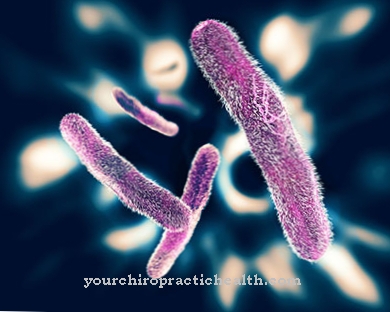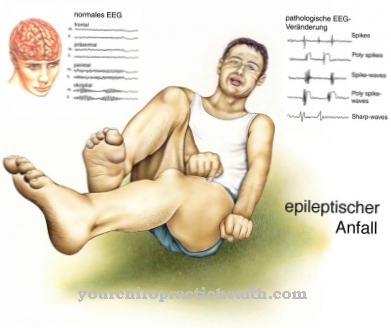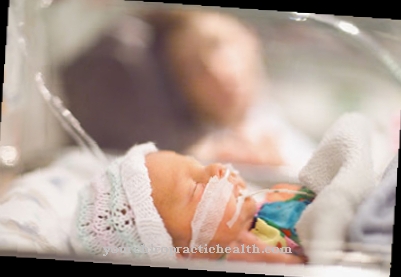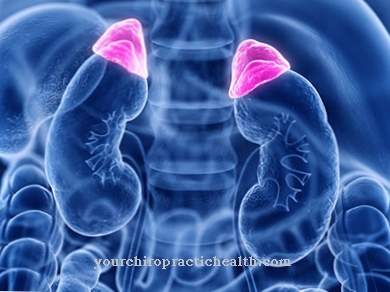As Erythroderma is a reddening of the skin that occurs all over the body. It is a collective term for various skin diseases.
What is erythroderma?

© ksenia_bravo - stock.adobe.com
Doctors speak of erythroderma when the skin is red all over the body. There is an inflammation of the skin associated with the expansion of the vessels. As a result, there is a loss of protein, salts and fluids. In the worst case scenario, subsequent infections can even endanger life. Erythroderma is not an independent disease. Rather, it is a symptom that is triggered by various diseases.
Erythroderma is a collective term for several dermatoses (skin diseases). Another typical feature of erythroderma is flaking of the skin. If the symptoms only appear in certain parts of the body, we speak of suberythroderma, which is classified as a special form. Erythroderma occurs twice as often in women as in men. The average age of onset is between 50 and 60 years.
causes
Erythroderma is a manifestation of an accelerated epidermal cell turnover. The cause for this has not yet been established. As a rule, erythroderma appears together with an underlying skin disease.
This can be seborrheic dermatitis, contact eczema, atopic eczema, pityriasis rubra pilaris or psoriasis.
However, taking certain drugs can also cause erythroderma. These drugs include sulfonamides, penicillin, barbiturates, phenytoin, or isoniazid. Malinomas such as leukemia (blood cancer), adenocarcinomas or mycosis fungoides are also considered to be triggers. However, around 25 percent of all patients do not have an underlying disease.
In medicine, erythroderma is divided into two forms: these are primary erythroderma and secondary erythroderma.
- The primary form shows itself without a previous illness and gives a response to an acute process. It occurs, among other things, in Sézary syndrome, mycosis fungoides, a drug eruption or old age erythroderma in men.
- Secondary erythroderma develops from a skin disease that is known beforehand. It is more common than the primary form and occurs in psoriasis or atopic eczema. Psoriasis accounts for around 25 percent of erythroderma.
You can find your medication here
➔ Medicines against redness and eczemaSymptoms, ailments & signs
As a rule, the symptoms of erythroderma appear all over the body of the person affected. This leads to reddening of the skin all over the body. Those affected also suffer from chills and fever. In addition, those affected suffer from itching and a general feeling of illness, so that the patients also appear tired and exhausted and thus do not participate in everyday life. The erythema is initially diffuse and manifests itself in the form of spots. In the further course the reddening of the skin spreads to almost the entire body.
The reddening also has a negative effect on the regulation of body temperature, so that those affected often sweat or freeze. Patients often have to dress warmly. Erythroderma can also lead to deficiency symptoms or various nutrient losses if the reddening persists.
Because there is also extensive peeling of the skin (epidermis), this has a negative effect on the regulation of body temperature. For this reason, the patients show an increased sensitivity to cold due to a loss of heat due to the expansion of the blood vessels. The affected people often put on warm clothes because they are cold.
Further problems are a lack of nutrients, which is caused by a pronounced loss of protein, as well as the increase in the metabolic rate with a hypercatabolic status. The transdermal loss of fluid also shows hypovolemia, in which the amount of blood within the bloodstream is reduced.
Due to extensive peripheral blood vessel dilation (vasodilation), there is also a risk of heart failure. In extreme cases, life can be in danger. The symptoms of erythroderma can also have a negative effect on the psychological state of the person concerned, so that some patients also suffer from depression or other psychological disorders.
diagnosis
To diagnose erythroderma, the treating physician first looks at the patient's medical history. He will then do a physical exam. If there is also a recognizable skin disease in addition to the typical symptoms, a causal connection can be established. If mycosis fungoides is suspected, tissue is removed (biopsy).
A blood test often reveals hypocalcemia, iron deficiency, or hypoproteinemia. In some cases, erythroderma can be life-threatening. For this reason, the patient usually has to go to a hospital. So there is a risk of significant complications.
When should you go to the doctor?
Redness of the skin is considered unusual no matter where it occurs on the body. A doctor should be seen as soon as they appear spontaneously or if they spread further. If the skin changes recur over several weeks or months, they should be presented to a doctor to clarify the cause. If further complaints set in, there is cause for concern. Open wounds can lead to the penetration of germs, which trigger additional diseases.
Itching, swelling, or dry skin layers should be examined and medicated. If the skin reddened after taking medication or taking certain foods, there may be an intolerance. A doctor should be seen for an allergy test to clarify the cause. Flaking of the skin indicates dryness of the skin layers. Relief can be achieved with an appropriate medicine. If the changes in the skin cause psychological problems or changes in mood, the person concerned should seek help.
Changes in behavior, a social withdrawal or feelings such as shame reduce general well-being. If the person concerned notices signs of inflammation on the skin, he should consult a doctor. He needs medical treatment if pus, pain, or an increased body temperature develops. Parasitic sensations in the skin are just as unusual and should be checked by a doctor.
Doctors & therapists in your area
Treatment & Therapy
Treatment for erythroderma depends on its extent and triggers. Since the accompanying symptoms often lead to a life-threatening condition, in-patient therapy must always be given in severe cases. This is especially true for acute and severe erythroderma because it is particularly dangerous. But even with a creeping form of the disease, from a certain severity onwards, treatment must take place in the hospital. There the patient receives medicines such as cortisone and sufficient fluids.
It is particularly important to counteract impending dehydration (dehydration) due to the considerable loss of fluid in the course of treatment.The same applies to the loss of protein and heat as well as to the vasodilation of the peripheral blood vessels, which puts a strain on the heart and circulation.
Drug eruptions cannot always be ruled out in erythroderma. For this reason, all drugs are discontinued or switched over as part of the therapy. In addition, the sick person may only receive medication that he absolutely needs. The patient is given emollients to care for the skin. If the erythroderma is severe, glucocorticoids such as prednisone are given. The patient initially takes 40 to 60 milligrams systemically for ten days.
Outlook & forecast
Erythroderma can be treated very well these days. If the condition is recognized at an early stage, drug treatment is usually sufficient to relieve the symptoms and discomfort. Once erythroderma has subsided, there are usually no further symptoms. If the disease is recognized too late or not adequately treated, the redness can spread to other parts of the body.
Drug treatment can reduce symptoms, but scars and pigmentation disorders may remain. Erythroderma generally has a good prognosis. Assuming appropriate treatment, the pathological reddening of the skin subsides within a few days to weeks. The responsible dermatologist can make an exact prognosis taking into account the course of the disease and the patient's state of health.
In order to achieve long-term improvement in the skin's appearance, the underlying disease must be treated. Otherwise, erythroderma can occur again and again, which increasingly worsens the complexion. Life expectancy is not reduced by erythroderma. Life expectancy can only be reduced if the underlying disease is severe, such as ichthyosis, as the disease then progresses.
You can find your medication here
➔ Medicines against redness and eczemaprevention
There are no known preventive measures against erythroderma. If the condition is triggered by certain drugs, it is necessary to discontinue them or to replace them with other drugs.
Aftercare
In the case of erythroderma, the patient has only very limited options for follow-up care. The patient is primarily dependent on medical treatment in order to permanently alleviate the symptoms and avoid further complications. Since erythroderma cannot heal itself, early diagnosis and treatment of this disease is very important in order to limit the spread of the symptoms.
In most cases, the symptoms are treated with medication or ointments and creams. The affected person should ensure that they are taken and applied regularly, and should also be consulted with a doctor. Since erythroderma can also lead to severe dehydration, it is advisable to ensure that you always drink enough water.
This is the only way to completely alleviate the symptoms. Even after successful treatment of erythroderma, the patient is dependent on regular medical examinations. If the symptoms recur, further treatment is necessary. The life expectancy of the patient is not reduced by the disease. In some cases, contact with other patients with the disease can also be useful.

.jpg)




.jpg)




















